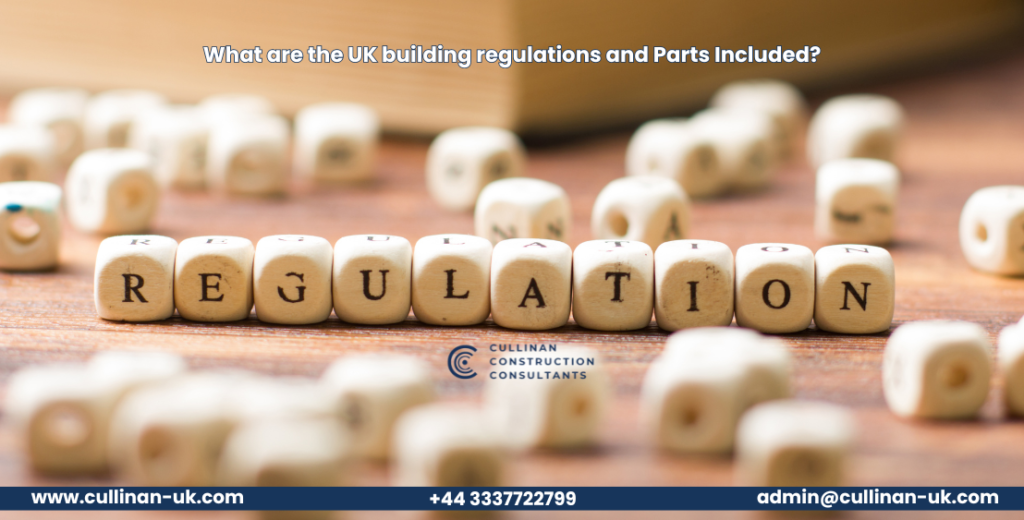What are the UK building regulations and Parts Included?

Building regulations in the UK are vital to ensure the security, safety, health and well-being of people in and around the buildings. These building regulations cover a variety of features from structural reliability to energy efficacy as well as fire safety. It is crucial for home owners professional builders and architects to recognize the importance of these regulations in construction or planning a renovation of a home or building. Building regulations are essential for ensuring that a project meets all legal requirements and are usually required by building control officers for approval.
Overview of UK Building Regulations
UK building regulations have established unified standards for the design and construction of buildings to ensure safety and sustainability. Depending on the building work these regulations are segregated into several parts. Compliance with these regulations is obligatory and failure to adhere results in substantial penalties and safety risks.
The primary purpose of building regulations is to:
Recognize the safety and health of people in and around building. Encourage energy efficiency and sustainability. Taking care of convenience and accessibility of people like those who are with disabilities.
Importance of Building Regulations
Following the building regulations is not just because of legal compliance but rather to ensure buildings are constructed while maintaining high standards, reducing risk, and achieving a good quality of life. For instance, accurate insulation and ventilation standards minimize energy usage which is cost-effective as well as eco-friendly.
Building regulations assure that structures can resist natural elements and usage over time hence decreasing the chance of structural failures. This is significant in areas prone to unfavourable weather conditions.
The building regulations are divided into many different segments each focusing on a specific area of building work. Following is a detail of each segment.
1. Structure
Part A, deals with the structural reliability of buildings. Certain standards are set for the strength and stability of buildings to avoid unfavourable incidents like collapse and excessive movements.

2. Fire Safety
Part B, focuses on ensuring the buildings are designed in such a manner, they minimize risk of fire and have immediate, safe escape routes for occupants. This part additionally addresses various aspects like fire detection and alarm systems, fire resistance of materials and emergency exits.

3. Preparation of site and protection against contaminants and Moisture
Part C, emphasizes making the site ready before construction and guarding the building from contaminants and moisture. This also includes drainage, damp proofing and ensuring the use of appropriate materials to contest contamination.

4. Toxic Substances
Part D, addresses the risk of toxic substances in buildings, particularly those that can arise from construction materials. It provides guidelines on how to handle and prevent exposure to these substances.

5. Resistance to the Passage of Sound
In this segment E, the sound installation feature is covered. To make sure buildings are designed in such a way that transmission of noise between rooms and the external environment is controlled. This ensures the comfort and privacy of residential buildings.

6. Ventilation
This segment F, includes ventilation standards of buildings. To prevent the risk of mold and condensation these regulations ensure sufficient fresh air is provided. Ventilation is essential for maintaining indoor air quality and occupant health.

7. Sanitation, Hot Water Safety and Water Efficiency
This part G, explains the sanitation facilities’ standards like hot water safety and water efficiency in buildings. This comprises of guidelines for installing toilets, bathrooms and other sanitary fittings. Also safeguarding the hot water systems is safe and efficient.

8. Drainage and Waste Disposal
In this part H, the guidelines for the design and installation of the drainage system are provided. This includes waste disposal systems and managing as well as controlling surface water. Appropriate drainage is important for the prevention of flooding and water damage.

9. Combustion Appliances and Fuel Storage Systems
This Part J, touches up the installation of combustion appliances and fuel storage systems to make sure they are safe and efficient. This incorporates standards for chimneys, flues and ventilation for combustion appliances.

10. Protection against Falling, Collision and its Impact
This segment K, touches upon the safety actions needed to safeguard occupants from falling, collision and its impact. This regulation incorporates staircases, ramps, balconies and glazing to avoid accidents and injuries.

11. Conservation of Fuel and Power
This part L, covers the standards necessary for energy efficiency in buildings, assuring the design and construction minimize energy consumption. This deals with the guidelines for insulation, heating systems as well as use of renewable energy sources.

12. Access to and Use of Buildings
This part M, provides standards to ensure buildings are designed in a way that they are accessible by all people including those with disabilities. There are guidelines for entrances, exits and conveniences to make buildings more inclusive.

13. Overheating
This regulation in Part O, ensures designing buildings to prevent overheating. Ensuring proper considerations to be taken for ventilation and channels to remove excess heat from indoor areas.

14. Electrical safety
Regulation in part P, communicate the electrical safety to avoid unfavorable injury or fire in building. Moreover, to ensure specific measures are taken to prevent shock or fire.

15. Security in Dwellings
This part Q, includes the standards that address the security measures needed for new dwellings making sure they are designed and constructed to resist unauthorized access. This comprises standards for doors, windows and other openings.

16. Infrastructure for electronic communications
This section R, includes the electronic communication infrastructure. Physical infrastructure for High-Speed Electronic Communications Networks is related to physical infrastructure to support broadband networks. Which may consist of the installation of ducts, and access points to facilitate connection to broadband services. This will enhance the digital connectivity requirements of buildings.

17. Infrastructure for Charging Electric Vehicles
This Part S, supports electrical Vehicle charging, it is mandatory that the residential or non-residential buildings or those buildings that are under renovation process must have the infrastructure that supports electrical vehicle Charging. This is an initiative towards the sustainability goals of the UK fostering the use of electric vehicles.

18. Toilet accommodation
Part T, of the regulations details technical guidance on the design and layout of toilets.

Compliance and Enforcement
As Building Regulations are administered by local building control bodies, these can be local authorities or approved inspectors. It is important to report to the relevant body before the commencement of work, to ensure inspections can be arranged at different stages when required for the smooth construction process.
Failure to comply with building regulations may result in unfavourable enforcement actions which include the requirement to rectify non-compliant work, fines or legal actions. Hence, it is vital to work closely with these regulatory bodies so that the project meets all required standards.
Consequences of Non-Compliance
Failure to comply with building regulations can lead to various consequences like enforcement notices that may require alteration or demolition. This can lead to a problem in selling or financing property, and potential legal action or fines can be charged.
By following the guidelines of the building regulations mentioned above, you may recognize that your building projects aliens with the highest standards of safety and quality.
These regulations mentioned in this blog were published on 16th July 2024.
The building regulations are updated at regular intervals to improve energy efficiency and help UK to achieve net zero carbon emission.
Any updates to regulation please follow this link, and to download the latest version of approved document, please visit this link.
Have questions please contact a professional or official government resources. Ensuring compliance with these regulations not only helps avoid legal issues but also contributes to creating a safer and more sustainable built environment.
* Too busy to read? Watch the video for a brief overview of the blog’s key points *









Comments are closed